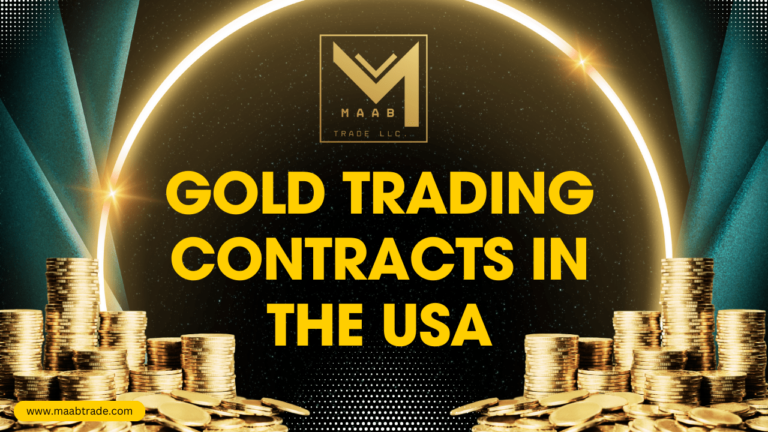Gold trading has long been a significant part of financial markets, serving as a hedge against inflation and a safe haven during economic uncertainty. In the USA, gold trading is primarily conducted through futures contracts, which allow traders to speculate on the price of gold without needing to hold the physical commodity. This comprehensive guide will delve into the intricacies of gold trading contracts in the USA, covering everything from contract specifications to trading strategies and market dynamics.
Understanding Gold Futures Contracts
What Are Gold Futures Contracts?
Gold futures contracts are legally binding agreements to buy or sell a specific amount of gold at a predetermined price on a specified future date. These contracts are standardized by futures exchanges, such as the Chicago Mercantile Exchange (CME), which ensures that all contracts have uniform terms regarding quantity, quality, and delivery conditions.
Key Features of Gold Futures Contracts
- Contract Size: The standard gold futures contract on the CME represents 100 troy ounces of gold. This means that when you purchase one contract, you are agreeing to buy or sell 100 troy ounces at the contract’s expiration.
- Fineness: Gold futures contracts typically specify a minimum fineness of 0.995, meaning that the gold must be at least 99.5% pure.
- Trading Units: In addition to standard contracts, CME offers mini and micro gold futures contracts, which represent smaller amounts of gold (10 ounces and 1 ounce, respectively). This allows for greater flexibility for traders with varying capital levels.
- Tick Size and Value: The minimum price movement for gold futures is $0.10 per troy ounce, equating to $10 per contract. This tick size allows traders to enter and exit positions with precision.
- Margin Requirements: Trading gold futures involves margin requirements, which are a fraction of the total contract value. For example, if gold is trading at $1,800 per ounce, a standard contract would be valued at $180,000. However, traders may only need to deposit a margin (e.g., $12,650) to control this position.
- Settlement: Gold futures can be settled either physically or financially. In physical settlement, actual delivery of gold occurs; in financial settlement, the difference between the contract price and market price is exchanged in cash.
The Importance of Gold Futures in Trading
Gold futures provide several advantages for traders:
- Leverage: Futures contracts allow traders to control large amounts of gold with relatively small capital outlay due to margin trading.
- Liquidity: The gold futures market is highly liquid, with millions of ounces traded daily. This liquidity ensures that traders can enter and exit positions easily without significant price slippage.
- Hedging: Gold futures are an effective tool for hedging against price fluctuations in the physical gold market. Producers and consumers can lock in prices to protect against adverse movements.
- Speculation: Traders can profit from price movements without needing to own physical gold. This flexibility attracts both institutional and retail investors.
How Gold Futures Contracts Work
Trading Mechanics
Gold futures are traded on exchanges like the CME Group almost 24 hours a day, allowing traders to react quickly to global events that impact prices. Here’s how trading typically works:
- Opening an Account: To trade gold futures, investors need to open an account with a brokerage that offers access to futures markets.
- Funding Your Account: After opening an account, traders must deposit funds to meet initial margin requirements.
- Placing Orders: Traders can place various types of orders (market orders, limit orders) based on their trading strategies.
- Monitoring Positions: Once positions are opened, traders must monitor market conditions and manage their risk through stop-loss orders or other risk management strategies.
- Closing Positions: Traders can close their positions before expiration by selling their contracts in the market or holding them until expiration for settlement.
Contract Expiration and Delivery
Gold futures have specific expiration dates when they must be settled. For CME contracts:
- The last trading day is typically the third last business day of the month preceding the delivery month.
- If a trader does not close their position before expiration and opts for physical delivery, they must be prepared to receive 100 troy ounces of gold.
Price Determination
The price of gold futures is influenced by various factors:
- Spot Price Movement: The current market price for physical gold directly affects future prices.
- Economic Indicators: Economic reports such as inflation rates, interest rates, and employment data can influence trader sentiment and demand for gold.
- Geopolitical Events: Political instability or crises often lead investors to seek safe-haven assets like gold, driving up prices.
- Currency Fluctuations: As gold is priced in USD, fluctuations in the dollar’s value can impact demand from foreign buyers.

Benefits of Trading Gold Futures in the USA
Diversification
Gold serves as an excellent diversification tool within an investment portfolio. By including gold futures alongside stocks and bonds, investors can reduce overall portfolio volatility and risk exposure.
Tax Advantages
In the USA, gains from trading gold futures may qualify for favorable tax treatment:
- Futures contracts are subject to 60/40 tax treatment under IRS rules; this means that 60% of gains are taxed at long-term capital gains rates while 40% are taxed at short-term rates regardless of how long you held the position.
No Management Fees
Unlike exchange-traded funds (ETFs) that charge management fees for holding positions over time, trading futures incurs no such fees. This cost-effectiveness can enhance overall returns on investment.
Risks Associated with Gold Futures Trading
While there are numerous benefits to trading gold futures, there are also risks that investors should be aware of:
Market Volatility
Gold prices can be highly volatile due to economic changes or geopolitical tensions. Sudden price swings can lead to significant losses if positions are not managed properly.
Leverage Risks
While leverage allows traders to control larger positions with smaller amounts of capital, it also magnifies potential losses. A small adverse movement in price could result in substantial losses exceeding initial investments if proper risk management strategies are not employed.
Margin Calls
If market prices move against a trader’s position significantly enough that equity falls below maintenance margin levels, brokers may issue margin calls requiring additional funds to maintain positions.
Strategies for Trading Gold Futures
Fundamental Analysis
Traders often analyze economic indicators such as GDP growth rates, inflation data, interest rate changes by central banks (like the Federal Reserve), and geopolitical events impacting global markets when making decisions about entering or exiting trades.
Technical Analysis
Many traders use charts and technical indicators (e.g., moving averages) to identify trends and potential reversal points in price movements over time:
- Support and Resistance Levels: Identifying key levels where prices tend to bounce back or reverse direction can help inform entry/exit points.
- Moving Averages: Using simple moving averages (SMA) or exponential moving averages (EMA) helps smooth out price fluctuations over specific periods.
- Volume Analysis: Monitoring trading volume alongside price movements can provide insights into market strength or weakness.

Hedging Strategies
Producers or consumers who deal with physical gold may use futures contracts as hedges against potential price fluctuations:
- Long Hedge: Buying futures contracts when expecting future increases in physical inventory costs protects against rising prices.
- Short Hedge: Selling futures contracts when anticipating declines in physical inventory values protects against falling prices.
Gold trading contracts represent an essential component of financial markets in the USA, providing opportunities for speculation and hedging against economic uncertainties. Understanding how these contracts work—from specifications like tick sizes and margins to strategies for successful trading—empowers investors to navigate this complex landscape effectively.
By leveraging knowledge about market dynamics and employing sound trading strategies while remaining aware of associated risks, traders can capitalize on opportunities presented by fluctuations in gold prices while managing their exposure effectively.
As always when engaging with financial markets—especially those involving leveraged products like futures—it’s crucial for participants to conduct thorough research and consider consulting financial professionals before making significant investment decisions related to gold trading contracts in the USA!


